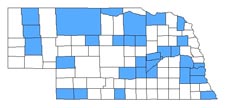
| Cicindela hirticollis shelfordi Graves |
| Adult Length: 12 to 16 mm |
| Appearance: Adults of this species are brownish bronze in color and generously marked. The marginal band is always broadly connected between the humeral lunule and the middle band (in Nebraska populations) and may or may not be narrowly connected to the apical lunule. The humeral lunule is distinct in that the rear edge of the posthumeral mark extends laterally or slightly forward and is typically re-curved toward the front at the end. |
| Similar Species: Cicindela repanda appears very similar, but the posthumeral section of the humeral lunule extends laterally to slightly forward and is normally re-curved at the end in C. hirticollis. In C. repanda this mark is not re-curved at the end and normally extends at a slight angle toward the rear. The middle band and humeral lunule are broadly connected in C. hirticollis (in Nebraska), while in C. repanda the two are either not connected or only very narrowly. In addition, the mandibles of C. hirticollis are markedly larger than those of C. repanda. It can be told from C. repanda by the whitish appearance of the ventral surface, the result of abundant setae. |
| Biology: This species is mostly limited to extensive sandy lake beaches, river sandbars, and low moist areas among sand dunes. It is also limited to areas that are infrequently disturbed. Adults apparently are strong dispersers and single individuals may turn up many miles from the nearest population. Where found it can often be abundant. Adults are very skittish and will usually fly about 10 to 20 meters when alarmed. The flight is fast and usually very low, often little more than 20 centimeters above the sand. This makes it a very difficult tiger beetle to net on the wing. Unlike C. repanda, it flies low and does not zigzag as C. repanda often does. |
| Adult Life History: Adults emerge in from late July to and September before overwintering. Activity resumes in April and May, although rare individuals may turn up as early as late March. Adults remain numerous throughout much of the summer and peak numbers occur in June. Because many adults survive into August, there is only a small drop in numbers in late summer. It is a spring-fall species. |
| Larval Life History: Larvae occur in vertical burrows in moist sand, exclusively where the water table is between 20 and 35 cm below the surface. Burrows are usually less than 15 cm deep and larvae will frequently abandon old burrows and dig new ones some distance away if soil moisture conditions change. Though Shelford (1908) reported a two-year life cycle in Illinois ( Chicago area), Knisley (1997) reports larval development completed in a single season in Virginia (4 months). In Nebraska most larvae complete their life cycle in a single season. This is evidenced by a general lack of third instars in early summer. Eggs are laid from April to July. Most larvae likely pupate in July while a few might only reach the third instar by fall. Those that pupate in July will emerge as adults in August and September while those only reaching the third instar by fall will pupate during the following summer and emerge thereafter. |
| Biogeography: This species is known from scattered locations across the entire state. It has apparently adapted to the sandy shores of many Nebraska reservoirs and is quite common along Lake McConaughy and a few smaller reservoirs. It is consistent in Loup River system. It was probably once common along the Platte River, but human alterations to the river have likely eliminated it from many areas. It is unable to survive downstream from dams except where open sand extends well above the high water mark. Dams and recreational traffic are major threats to this species throughout its range and it has apparently been eliminated from several eastern states. In North America it has a broad distribution across most of the continent. It is found along both the Atlantic and Pacific coasts, and across most of the United States except the Great Basin and the Appalachian Mountain region. It ranges north to northern Alberta and Saskatchewan. Eleven subspecies have been described, but there is disagreement on the validity of at least one. Current research on this species should reveal more information on the biogeographical relationships within it. |




